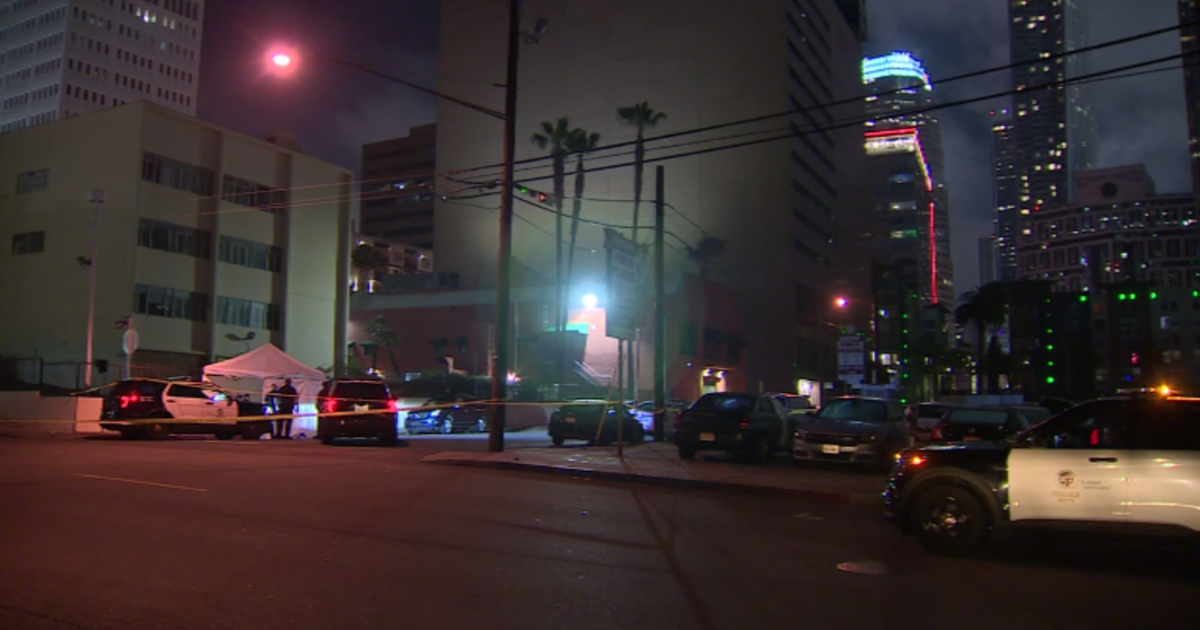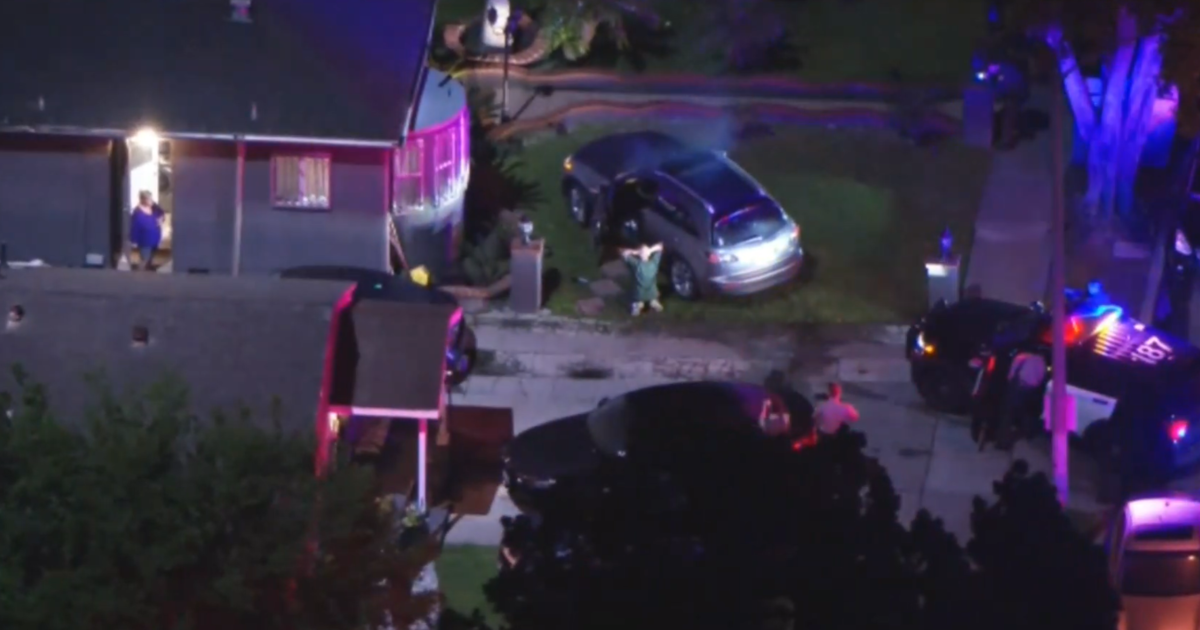Storm Soaks Southland, Prompts Mudslide Concerns And Evacuation Warnings
LOS ANGELES (CBSLA) – Heavy rains drenched Southern California Monday, raising mudslide concerns in recent burn areas and prompting evacuations.
A mudslide late Monday morning forced the closure of a stretch of Pacific Coast Highway from roughly Broad Beach Road into Malibu into Ventura County. The roadway remained blocked until about 4 p.m.
Meanwhile, snowfall in the northern reaches of Los Angeles County prompted a full closure of the 5 through the Grapevine, where multiple vehicles were reported to be stuck in the snow. Shortly after 4 p.m., California Highway.
RELATED: PCH, Grapevine Reopen As Storm Brings Rain, Snow To SoCal
Patrol officers began escorting small groups of vehicles that got stuck in the closure on the northbound side out of the area. The freeway, however, remained closed.
Daily maximum rainfall records were set Monday at Hollywood Burbank Airport and in the Los Angeles County mountain community of Sandberg, according to the National Weather Service. The Burbank airport got 1.4 inches of rain, breaking the old record of 1.03 inches set in 1993.
In Sandberg, 1.21 inches fell, breaking the old record of 1.13 inches set in 1978.
Los Angeles County officials issued mandatory evacuations in parts of the Woolsey Fire burn area beginning at 8 a.m. Tuesday.
The Orange County Sheriff's Department issued a voluntary evacuation order for neighborhoods near the Holy Fire burn area, noting that "flooding and debris flows are possible and evacuation routes can quickly become impassable."
Sheriff's officials said the heaviest rain fell in the burn area from Monday afternoon until 7 p.m. The voluntary evacuation order "is a precautionary measure and there are no road closures at this time," sheriff's officials said shortly before noon.
Four Malibu schools – Malibu Middle and High School, Juan Cabrillo, Point Dume and Webster – will be closed Tuesday, the school system tweeted Monday night.
A flash flood watch was in effect in Orange County for coastal, inland and mountain areas.
"Heavy rainfall of 1 to 2 inches, with localized amounts up to 3 inches along the coastal slopes, is forecast to occur," according to an NWS statement forecasting Orange County conditions. "Rainfall amounts of one half to one inch could fall in one hour, with the heaviest rates occurring near the coast.
"There is the potential of mud slides and debris flows at recent burn scars, particularly near the Holy Fire burn scar. Debris flows can happen suddenly with little time to act. Heed the advice of local officials. In addition, street flooding is possible along with the possibility of some road closures."
Early Monday morning, the National Weather Service issued an Urban and Small Stream Flood Advisory for western Los Angeles County due to the persistent rain falling in the area. That advisory was allowed to expire at 9:30 a.m.
Monday's storm was expected to produce between a half-inch and 1 1/2 inches of rain and up to 2 1/2 inches in the mountains and foothills, NWS meteorologist Todd Hall said. Two more storms are expected to roll through the area this week, generating between 3 and 6 inches of rain in coastal valleys and 7 to 9 inches in mountains and foothills, he said.
"It's going to be a very wet week for Southern California," Hall said.
The Woolsey Fire area in Ventura County and in the Malibu area in L.A. County is the most vulnerable of the region's burn areas, Hall said. The Los Angeles County Sheriff's Department emphasized the risks in a statement." Authorities warn that all residents who live in or near the Woolsey Fire burn area should remain aware of their surroundings and weather conditions during these storms. Even small amounts of rainfall rates may result in significant mud and debris flow, so we strongly encourage residents who live in or near Woolsey Fire burn areas to be ready to evacuate at a moment's notice," said Los Angeles County Sheriff's Capt. Darren Harris.
The Sepulveda Basin was closed Monday afternoon due to flooding, according to an announcement from the office of City Councilman Paul Krekorian.
L.A. County public safety officials said communities in low-lying areas or next to steep slopes or waterways are particularly at-risk of falling debris and mud flow. Residents living in homes with limited roadway access or that can become isolated for an extended period due to the storm should consider leaving before storms arrive, and homes or neighborhoods with gates should consider leaving them open to avoid being trapped due to mud flow accumulation; even one-inch of mud can restrict gate operations.
"If your property becomes unsafe and there is no time to evacuate, seek safe high-ground," urged the sheriff department statement. It added: "Since all canyon roads may be blocked and subject to closure for extended periods, residents should have enough food, water, medication and supplies for at least seven to 10 days for all family members, including pets and large animals."
Forecasters said rain was expected to taper off this evening, giving us a short break until tomorrow afternoon, when a potentially more potent storm moves in.
"This one may be the strongest of the week, with a strong southerly component to the low level winds and good instability, especially in the afternoon," according to the NWS.
A flash flood watch will be in effect Tuesday afternoon and evening for most of the Southland, particularly the recent Woolsey and La Tuna fire burn areas, where rainfall rates could range from 1/2 to one inch per hour, along with the chance of isolated thunderstorms.
"There is an elevated risk of flash flooding and mud and debris flows in and around recent burn areas in the watch area," according to the NWS.
"In addition, roadway flooding is likely, especially in low-lying areas, along with rock and mudslides on canyon roads and below steep terrain." A winter storm warning denoting potentially perilous conditions will be in effect in the San Gabriel Mountains until 10 a.m. Tuesday, according to the NWS.
Heavy snow is expected, with snow accumulation of 6-12 inches anticipated above 5,000 feet and 1-3 inches between 4,000 and 5,000 feet, according to the NWS. There also could be light slow accumulation down to 3,500 feet, which could affect Interstate 5 through The Grapevine.
Meanwhile, "damaging" winds of 25-35 mph gusting at up to 60 mph will buffet the northwest San Gabriels, including the Interstate 5 corridor, the weather service said. But no other warnings of high winds were issued for any other part of L.A. County early this morning.
"Plan on difficult travel conditions, including during the evening commute on Monday and the morning commute Tuesday. Be prepared for significant reductions and invisibility at times," according to the NWS statement discussing mountain conditions. A Winter Storm Warning for snow means severe winter weather conditions will make travel very hazardous or impossible.
"If you must travel, keep an extra flashlight, food and water in your vehicle in case of an emergency. The latest road conditions from Caltrans are available by calling (800) 427-7623."
Along the L.A. County coast, breaking waves of 4 to 7 feet, with maximum sets of 8 feet, are expected, increasing to 5 to 8 feet through Tuesday, according to the NWS. The high surf then is likely to continue Tuesday night through Friday.
The conditions create "an increased risk for ocean drowning," warned an NWS statement on maritime conditions. "Rip currents can pull swimmers and surfers out to sea. Large breaking waves can cause injury, wash people off beaches and rocks, and capsize small boats near shore."
Forecasters warned swimmers who get caught in a rip current to "relax and float. Don't swim against the current. If able, swim in a direction following the shoreline. If unable to escape, face the shore and call or wave for help."
The rain is expected to again taper off Tuesday night and early Wednesday, but a third storm will move in late Wednesday and continue into Thursday. Forecasters say that storm could bring longer durations of rain that could again prompt flood watches.
"Given the amount of rain that will have fallen to that point, areas outside the burn areas may be at an increased risk for flooding, especially near smaller, flashier creeks and rivers, and other threats such as falling trees and rockslides," according to the NWS.
(© Copyright 2018 CBS Broadcasting Inc. All Rights Reserved. City News Service contributed to this report.)



